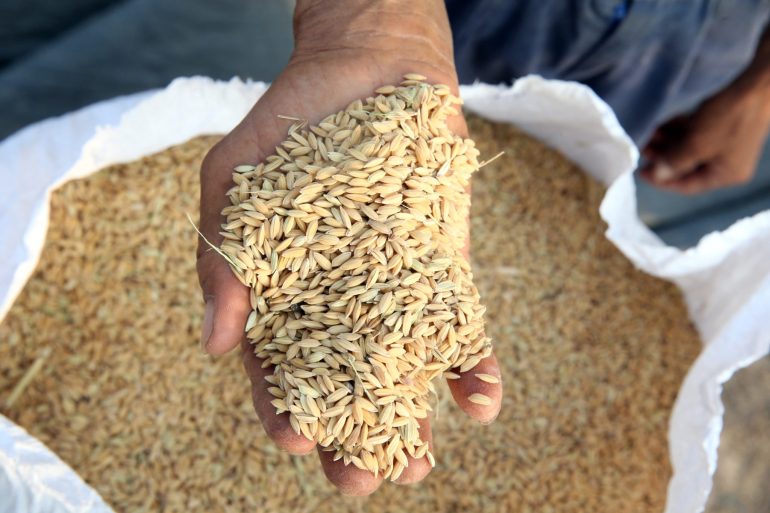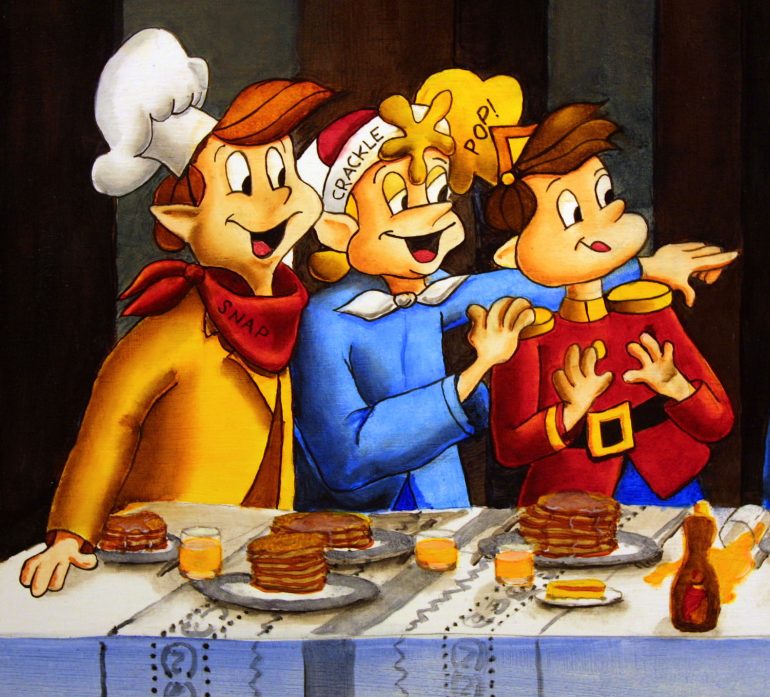Released to the public in 1928, Rice Krispies were not the first of Kelloggs’ cereal creations; that honour goes to Corn Flakes and is covered in our article “How are Corn Flakes Made?” Nevertheless, this toasted rice breakfast became an instant hit.
In the UK alone, 1.5 million boxes were sold in 1930, and that was two years before its charismatic cartoon trio Snap, Crackle and Pop even made their debut. Today, that number is closer to 20 million.
The question is, how are Rice Krispies made? To cover this, we’ll look at the cereal’s origins and then find out, how are Rice Krispies made in factory settings? So, let’s get going and discover how Rice Krispies are made.
How Rice Krispies are Made: Origins

Rice Krispies for breakfast (Photo: Catherine Delahaye via Getty Images)
In asking “how are Rice Krispies made”, it is vital to distinguish between rice that is “puffed” and that which is “popped”. Rice Krispies fall into the puffed rice category, which means they remain shaped as grains of rice, albeit enlarged. Popped rice more resembles popped corn, with its irregular form. We’ll examine the different processes shortly, but it’s worth noting that both types of rice were around in much of Asia for decades – if not centuries – before Kellogg’s made theirs. In China, there are written mentions of puffed rice as far back as the 12th century.
In the West, it was botanist Alexander P. Anderson who happened upon the process of making puffed rice in 1901. He was experimenting with cornstarch in a vacuum when he found that placing it under extreme heat and pressure then suddenly removing that pressure caused the starch to puff out. A year later, he filed a patent for “a dry method of swelling starch materials of all kinds” and, in 1909, a cereal company began selling his puffed rice. However it wasn’t Kellogg’s. It was Quaker Oats and the cereal was called Puffed Rice.
It was only in 1928 that Rice Krispies came to market in the US and UK. Over the years, different forms of Rice Krispies have been introduced, including Coco Pops and Multigrain Shapes. Rice Krispie Treats were invented by Kellogg’s in 1939. Improvements over time have included a 30 percent sugar reduction in 2010, a further 20 percent in 2018, and added vitamin D in 2011.
Now that we’ve examined their beginnings, how are Rice Krispies made in factory settings?
How are Rice Krispies Manufactured? An Overview

A delicious Rice Krispy square ( Photo: LongHa2006 via Getty Images)
Answering the question “how are Rice Krispies produced” is trickier than it might seem. Cereal companies are notoriously secretive about their recipes and processes, and Kellogg’s is no exception. Indeed, according to Kellogg’s, the process is described as follows:
- Rice is harvested and milled before being transported to the factory.
- At the factory it is mixed with a ‘lightly sweetened malt flavouring’ and cooked.
- It is then dried, rolled and rested before being toasted into the crispy puffs that we know as Rice Krispies.
While impossible to detail every ingredient or step of how Rice Krispies are made, what follows lifts the lid on the usual processes of making such a cereal.
How are Rice Krispies Made in Factory Settings?

Harvesting rice grain (Photo: Pascal Deloche / Godong via Getty Images)
The main ingredient in Rice Krispies is, of course, rice. Indeed, every Rice Krispie is a grain of rice. A standard pack of the popular cereal contains some 18,000 individual medium grain kernels. This is transported to the factory from a nearby mill, where it has been cleaned of all bran and germ. As for the malt flavouring mentioned above, this is usually mostly made up of a solution of sugar, salt and malt extract dissolved in water.
How are Rice Krispies Made? Under Pressure
How Rice Krispies are made is not all that different to making popcorn. Like corn, rice has the starch and hard shell that make it ideal for oven popping. However, rice does not contain the natural moisture required for the popping process. So, the first step is to add just that. This is done by way of steaming.
Thus, in the first step in “how are Rice Krispies manufactured”, the rice and malt solution are combined in a pressure cooker, where they are steamed for around an hour at a pressure of roughly between 103 and 125 Kilopascal at around 180 degrees centigrade.
Cooling and Separating
Next, the steamed rice is removed from the cooker and allowed to cool and the grains separated.
Partial Drying
The rice is allowed to dry for an average time of six hours, or however long it takes for it to reach a moisture level of between 17 and 28 percent.
Bumping
Ever wondered just how are Rice Krispies produced to be so tremendously puffy? Well, bumping plays a vital role in achieving this. This is where the rice is passed through flaking rolls similar to those of cornflakes, but only to slightly compress them. This process also has the benefit of opening up cracks in the rice structure, which act as vents when they are later toasted.
Final Drying
This second round of drying brings the moisture level of the rice down to around 10 percent, at which point it is ready for toasting.
Puffing
It’s the toasting stage in how Rice Krispies are made that transforms them into the crackly puffs everybody knows, but it is also the quickest of the processes, taking just 90 seconds. During this time, the rice is heated to temperatures of up to 340 degrees centigrade inside a rotary oven.
Additions
Newly toasted and puffed, the Rice Krispies are cooled before undergoing a number of possible processes including spray fortification with vitamins and antioxidant treatment, which extends their shelf life.
Packaging
The complete Rice Krispies need only be packaged. They travel along tubes in the bag filling machine, which fills the cereal bags according to weight before they are sealed and boxed.
How Rice Krispies are Made to Snap, Crackle and Pop

Breakfast cereal cartoon characters "Snap, Crackle and Pop" February 22, 2001 (Photo: Tim Boyle via Getty Images)
And then the Rice Krispies travel to shops and finally breakfast tables. But one mystery remains… In Danish it’s ‘Pyf! Paaf! Pof!’ In German? ‘Knisper! Knasper! Knusper!’ And as for French, it goes ‘Cric! Crac! Croc!’ In whatever language it is exclaimed, Snap, Crackle and Pop has become synonymous with the Kellogg’s cereal Rice Krispies and its three noisily-named mascots. So, how are Rice Krispies made to emit their inimitable sounds?
It’s all about the air inside the rice grains. As mentioned above, bumping the rice grains before toasting them allows air inside through newly formed cracks in their structure. Well, when the milk starts filling the Rice Krispies, the air needs a way out; and quickly. This quick escape of air is what’s making all that noise.
And that’s it. The answer to “how are Rice Krispies produced”, from their invention right through to modern manufacturing.











